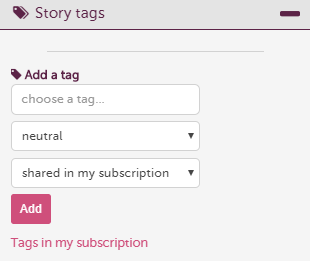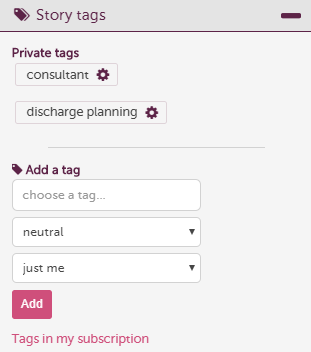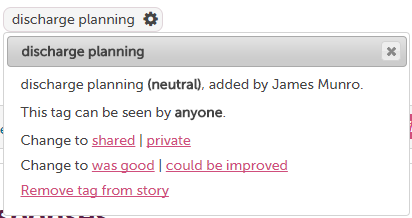
I'm pleased to say that we've just released the first version of a new feature for subscribers: "story tagging".
What's that? Well, a tag is one of those "keywords" you see listed below a story, which helps to describe what it is about. You can click the tags to find similar stories, or construct complex searches for stories tagged in various ways.
Many of the tags on Care Opinion describe conditions, procedures or treatments. Others relate to communication, emotion, staff or the care environment. When someone posts a story on Care Opinion, they add tags to help other people (and you!) find their story.
And now you (as a subscriber) can add your own tags too.
Why would I want to add tags to stories?
Lots of reasons!
Perhaps you are planning a quality improvement project on experiences of postnatal care? As your stories come in, add a postnatal-qi tag to relevant stories. You can set the tag as private (only you can see it), shared (you and your colleagues can see it) or public (everyone can see it).
Whenever you want, you can click on the tag to collect up the set of stories. And then, of course, you can share them in a report, summarise them, or (soon) make an interactive visualisation from them.
A shared or public tag means you can share the work too - if colleagues all look out for relevant stories and add the postnatal-qi tag, you'll be able to collect up all the stories tagged by anyone.
Some other times when tagging might help you:
- you want to find and count stories according to a set of quality standards your organisation defines
- your research project requires a set of stories about a given issue
- you are using stories in education and want students to read and discuss a set of stories you found
- you might even want students to each tag two stories, ready to share in a group session
So how do I add a tag?
First, you'll need to be logged in to your subscription.
Go to the story you want to tag. (You can add a tag to any story.) Below the story, select [Add a tag], to show the tagging area:
In the first box, type your tag name. (You can choose an existing tag or make up a new one.)
In the second box, choose whether you are tagging neutrally, positively or negatively. For example, imagine you are collecting experiences of discharge arrangements. You might add the tag "discharge planning" to such stories. Sometimes you want to show the experience as positive, sometimes as negative.
In the third box, you choose who can see the tag: just you, you and colleagues, or everyone.
Then select [Add] and the tag is added:
Can I change or remove the tag?
Yes, you can change or remove tags you added. (If you are a subscription admin, you can change other people's tags too.)
In the picture above, somebody else added the tag "consultant". You can't change that. But you added "discharge planning", and that little cog shows that you can change it.
Select the cog, and you'll see options to change the positive/negative status, change the visibility, or just remove the tag completely.
Bear in mind that if you make a tag public, everyone can see it, including the author of the story. So your use of tagging should always be respectful, and not change the author's intent in telling their story.
What next?
There's plenty more to say, on searching, reviewing your tags, and using them creatively.
But this post is long enough already. More in the next post!
Now *you* can tag stories too
Now *you* can tag stories too https://careopinionuk-staging.azurewebsites.net/resources/blog-resources/27-images/687cb62bd86540c79ab3a973b98bab59.png Care Opinion 0114 281 6256 https://www.careopinion.org.uk /content/uk/logos/co-header-logo-2020-default.pngChange from Care Opinion tech
Posted by James Munro, Chief executive, Care Opinion, on
Thanks for your feedback.
Response from James Munro, Director of Research & Development, Care Opinion on 22 Aug 2017 at 09:21
Another thought on uses for tags: you might want to use them as "notes to self".
For example, you might add a private tag of "should lead to change", or "share at Jan 2018 service review" or some such. Because the tag is private, only you can see it.
Then, when the time comes, just search on that tag to collect up the stories you tagged, report them, visualise them, or whatever you need.
Response from James Munro, Chief executive, Care Opinion on 4 Sep 2017 at 20:35
I've posted a follow up to this blog with info about searching for tagged stories. Enjoy!



